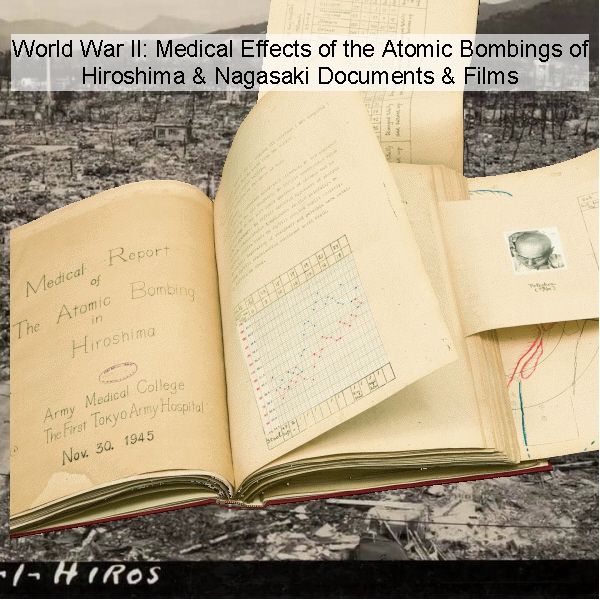
World War II: Medical Effects of the Atomic Bombings of Hiroshima & Nagasaki
$19.50
Description
Hiroshima and Nagasaki Atomic Bomb Medical Effects: A Timeline
Timeline of Main Events (Based on Provided Source Descriptions)
This timeline focuses on the key events and periods documented within the described collection of reports and films concerning the medical effects of the atomic bombings of Hiroshima and Nagasaki.
- August 6, 1945: Atomic bomb dropped on Hiroshima.
- August 9, 1945: Atomic bomb dropped on Nagasaki.
- Post-August 9, 1945: Initial investigations of the atomic effects in Hiroshima and Nagasaki begin. This includes Japanese investigations and the early stages of American assessment.
- September 21, 1945 – April 5, 1946: The United States Air Force films the aftermath and likely initial medical effects in Hiroshima and Nagasaki.
- 1945: The Japanese Army Medical College and the 1st Tokyo Army Hospital produce their “Medical Report of the Atomic Bombing in Hiroshima.”
- 1946: The Manhattan Engineer District compiles “The Atomic Bombings of Hiroshima and Nagasaki,” summarizing information on damage, injuries, and morale effects.
- May 1946: The Surgeon General of the U.S. Army, General Kirk, writes to the Chairman of the Division of Medical Sciences of the National Research Council, highlighting the need for a careful follow-up of Japanese casualties.
- January 1947: The Atomic Bomb Casualty Commission (ABCC) publishes its “General Report,” outlining the initial American analysis of casualties, building upon earlier joint Army and Navy commission findings and Japanese investigations.
- 1947: The United States Strategic Bombing Survey produces “The Effects of Atomic Bombs on Health and Medical Services in Hiroshima and Nagasaki,” detailing immediate and remote health effects and the impact on medical infrastructure.
- 1948: A “Medical Indoctrination Course” is sponsored by the Armed Forces Special Weapons Project.
- 1948: The Radiation Effects Research Foundation (RERF) begins its investigations into the long-term radiation effects in atomic bomb survivors, succeeding the ABCC.
- 1949: The Armed Forces Special Weapons Project releases “Medical Aspects of Nuclear Energy.”
- 1951: The Joint Commission for the Investigation of the Effects of the Atomic Bomb in Japan publishes “Medical Effects of Atomic Bombs,” Volume 1, aiming to compare the effects in Hiroshima and Nagasaki.
- 1951: The Atomic Bomb Casualty Commission collects data on maturation, body build, and posture of approximately 4,800 Hiroshima children.
- 1952: The Atomic Bomb Casualty Commission publishes a report analyzing the 1951 observations on Hiroshima children’s growth and development.
- 1946-1955: The Atomic Bomb Casualty Commission conducts studies on the effect of atomic bomb exposure on pregnancy termination.
- 1956: A report is published by the Atomic Bomb Casualty Commission detailing the findings on pregnancy termination in Hiroshima and Nagasaki.
- 1978: Finch and Iwao highlight the necessity of reliable radiation dose estimates for understanding late health effects in RERF investigations.
- 1983-1986: Joint U.S.-Japan research programs and oversight committees conduct a thorough review of the radiation dosimetry for the atomic bombs.
- 1986: The Dosimetry System 1986 (DS86) is finalized.
- 1987: A final two-volume report is prepared by RERF discussing the physical basis for DS86. Another two-volume final report from the US-Japan Joint Reassessment of Atomic Bomb Radiation Dosimetry (DS86) is also published.
- 1988: A paper is published on the application of the DS86 methods to individual survivors in RERF’s major study populations.
- 2000: A report on the “Status of the Dosimetry for the Radiation Effects Research Foundation (DS86)” is released.
- Post-2000: Research continues, leading to the development of the Dosimetry System 2002 (DS02), documented in multiple volumes.
- 2011: A publication titled “Long-term Radiation-Related Health Effects in a Unique Human Population Lessons Learned from the Atomic Bomb Survivors of Hiroshima and Nagasaki” reviews risk estimates and summarizes the findings of over 63 years of study by the ABCC and RERF.
Cast of Characters (Principle People Mentioned)
This cast lists the principal individuals explicitly named within the descriptions of the provided sources.
- Major General Leslie R. Groves: Director of the Manhattan Engineer District (Manhattan Project). Oversaw the compilation of the 1946 report on the atomic bombings.
- Dr. Austin M. Brues: Co-author of the January 1947 Atomic Bomb Casualty Commission “General Report” on the medical and biological effects of the bombings.
- Dr. Paul S. Henshav: Co-author of the January 1947 Atomic Bomb Casualty Commission “General Report” on the medical and biological effects of the bombings.
- General Kirk: The Surgeon General of the U.S. Army who, in May 1946, requested the National Research Council to undertake a survey on the follow-up of Japanese casualties.
- Finch: Co-author (with Iwao) of a 1978 publication highlighting the importance of reliable radiation dose estimates for RERF studies.
- Iwao: Co-author (with Finch) of a 1978 publication highlighting the importance of reliable radiation dose estimates for RERF studies.
World War II: Medical Effects of the Atomic Bombings of Hiroshima & Nagasaki Documents & Films
3,928 pages of reports and 3 hours and 40 minutes of film, covering the medical effects of the atomic bombings of Hiroshima & Nagasaki.
Reports date from 1945 to 2011, and were produced by the Japanese Army Medical College, 1st Tokyo Army Hospital, Manhattan Engineer District (Manhattan Project), United States Bombing Survey, Atomic Bomb Casualty Commission, Armed Forces Special Weapons Project, United States Atomic Energy Commission, Radiation Effects Research Foundation and the Oak Ridge National Laboratory.
REPORTS
Medical Report of the Atomic Bombing in Hiroshima Rikugun Gun’i Gakko¯ (1945)
An English translation of a report by the Japanese Army Medical College & the 1st Tokyo Army Hospital.
The Atomic Bombings of Hiroshima and Nagasaki by the Manhattan District (1946)
Abstract: This report describes the effects of the atomic bombs which were dropped on the Japanese cities of Hiroshima and Nagasaki on August 6 and 9, 1945 respectively. It summarizes all the authentic information that is available on damage to structures, injuries to personnel, morale effect, etc., which can be released at this time without prejudicing the security of the United States. This report has been compiled by the Manhattan Engineer District of the United States Army under the direction of Major General Leslie R. Groves, Special acknowledgement to those whose work contributed largely to this report is made to; The Special Manhattan Engineer District Investigating Group, The United States Strategic Bombing Survey, The British Mission to Japan, and The Joint Atomic Bomb Investigating Group (Medical).
General Report Atomic Bomb Casualty Commission January (1947)
From Forward: The report by Dr. Austin M. Brues and Dr. Paul S. Henshav is one of the series of studies which have been made on the medical and biological effects of the atomic bombs dropped in Japan. The initial American investigations were made by a joint Army and Navy commission and the findings of this commission constitute the first American analysis of the casualties. Various Japanese investigations of the atomic effects had been made even before the American commission entered Japan. Key data are, therefore, contained in the various documents and the present report grew naturally out of the necessity for a continuing study of these medical and biological effects. The National Research Council’s connection with the problem came through a letter from the Surgeon General, U. S. Army, written in May 1946, to the Chairman of the Division of Medical Sciences. In this letter, General Kirk pointed out the desirability of a careful follow-up of the Japanese casualties and requested that the Council undertake a survey of the possible methods of achieving the desired results.
The Effects of Atomic Bombs on Health and Medical Services in Hiroshima and Nagasaki (1947)
Produced by the United States Strategic Bombing Survey. From the introduction: The report presented here briefly outlines the immediate and remote measurable effects of the atomic bombs and the subsequent widespread fires on the health of the civilian population. The investigation includes the different phases of public health following the outline used in the overall health survey of Japan. This report contains chapters which relate to medical and health facilities and services, nature of air-raid casualties, sanitary facilities and services, food supply and nutrition, communicable diseases, and industrial health and hygiene.
Medical Effects of Atomic Bombs The Report of the Joint Commission for The Investigation of The Effects of the Atomic Bomb in Japan Volume 1 (1951)
From the reports introduction: It is desirable to present a summary of the studies that were made in Hiroshima and Nagasaki in such a way that a comparison of the effects of the atomic bombing of the two cities is possible. Since the structural condition of the cities and disposition of the population were widely diverse, this comparison does not necessarily reflect the relative effect of the bomb in each city.
The Growth and Development Program of the Atomic Bomb Casualty Commission – Analysis of Observations on Maturation, Body Build and Posture Taken in 1951 on 4,800 Hiroshima Children (1952)
A report by the Atomic Bomb Casualty Commission.
The Effect of Exposure to the Atomic Bombs on Pregnancy Termination in Hiroshima and Nagasaki (1956)
From the report: The present monograph is designed as a detailed report on certain efforts made during the period 1946-1955 to provide answers to the following two questions: 1. Can there be observed, during the first year of life, any differences between the children born to parents, one or both of whom were exposed to the effects of the atomic bombings of Hiroshima and Nagasaki, and the children born to suitable control parents, and 2. If differences do exist, how are these to be interpreted?
The New Radiation Dosimetry for the A-Bombs in Hiroshima and Nagasaki (1988)
From the introduction: Various radiation effects in the A-bomb survivors and their offspring have been investigated since 1948 by a cooperative Japan-United States research organization, known as the Radiation Effects Research Foundation (RERF). A reliable estimate of radiation dose to each of the individual survivors is essential to the understanding of late health effects occurring in the various RERF investigations (Finch and Iwao, 1978). Without reliable dose estimates, meaningful assessment of carcinogenic and genetic risk is not possible.
In 1983, joint U.S.-Japan research programs and oversight committees were established to conduct a thorough review of all aspects of the radiation dosimetry for the atomic bombs in Hiroshima and Nagasaki (RERF, 1983; RERF, 1984). The review was completed in 1986 and a final two-volume report was prepared (RERF, 1987) that discusses the physical basis for Dosimetry System 1986 (DS86). This paper deals with the application of the DS86 methods to individual survivors in the major study populations of RERF.
Long-term Radiation-Related Health Effects in a Unique Human Population Lessons Learned from the Atomic Bomb Survivors of Hiroshima and Nagasaki (2011)
Abstract: For 63 years scientists in the Atomic Bomb Casualty Commission and its successor, the Radiation Effects Research Foundation, have been assessing the long-term health effects in the survivors of the atomic bombings of Hiroshima and Nagasaki and in their children. The identification and follow-up of a large population (approximately a total of 200,000, of whom more than 40% are alive today) that includes a broad range of ages and radiation exposure doses, and healthy representatives of both sexes; establishment of well-defined cohorts whose members have been studied longitudinally, including some with biennial health examinations and a high survivor participation rate; and careful reconstructions of individual radiation doses have resulted in reliable excess relative risk estimates for radiation-related health effects, including cancer and noncancer effects in humans, for the benefit of the survivors and for all humankind. This article reviews those risk estimates and summarizes what has been learned from this historic and unique study.
Other reports include:
Medical Indoctrination Course Sponsored by Armed Forces Special Weapons Project (1948)
Medical Aspects of Nuclear Energy – Armed Forces Special Weapons Project (1949)
US-Japan Joint Reassessment of Atomic Bomb Radiation Dosimetry in Hiroshima and Nagasaki Final Report (DS86) Volume 1 (1987)
Status of the Dosimetry for the Radiation Effects Research Foundation (DS86) (2000)
Reassessment of the Atomic Bomb Radiation Dosimetry for Hiroshima and Nagasaki – Dosimetry System 2002 (DS02) Volume 1
Reassessment of the Atomic Bomb Radiation Dosimetry for Hiroshima and Nagasaki – Dosimetry System 2002 (DS02) Volume 2
US-Japan Joint Reassessment of Atomic Bomb Radiation Dosimetry in Hiroshima and Nagasaki Final Report (DS86) Volume 2 (Appendix to Volume 1) (1987)
FILMS
3 hours and 40 minutes of reference copies of films, in four segments with shot lists, filmed between September 21, 1945 to April 5, 1946, by the United States Air Force.









Related products
-
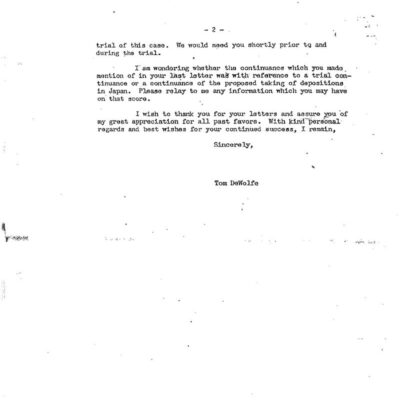
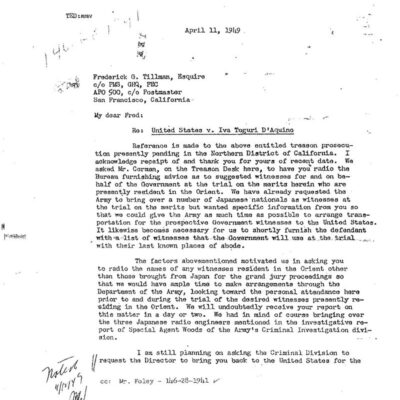
Tokyo Rose: Department of Justice Prosecution Files
$19.50 Add to Cart -

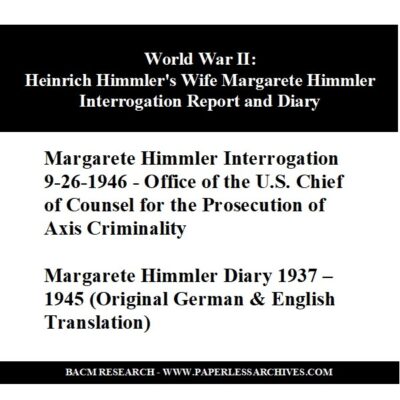
World War II: Interrogation Report and Diary of Margarete Himmler, Wife of Heinrich Himmler
$3.94 Add to Cart -
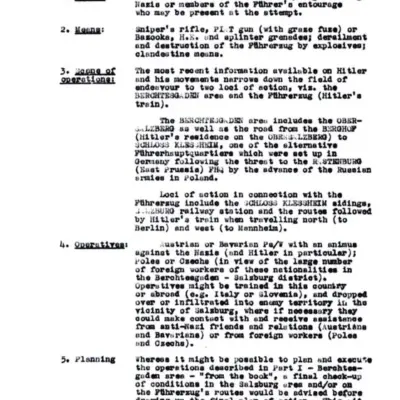
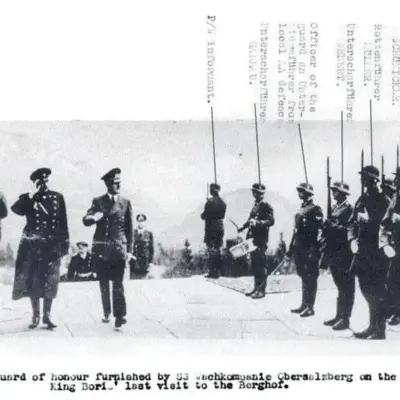
World War II: Adolf Hitler and Operation Foxley – British Assassination Plot
$19.50 Add to Cart -
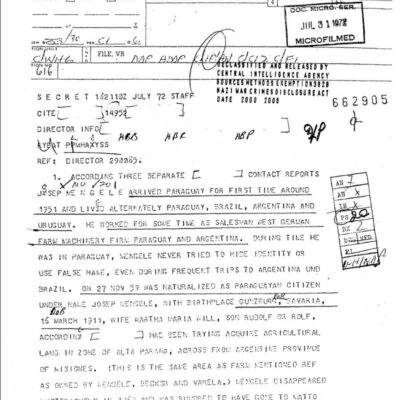

Josef Mengele CIA Files
$19.50 Add to Cart